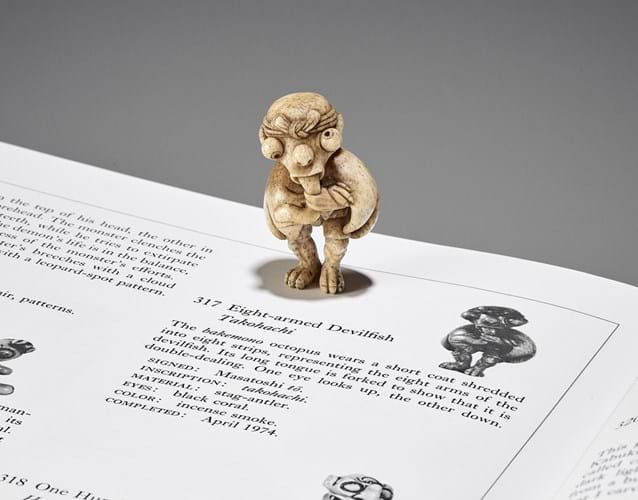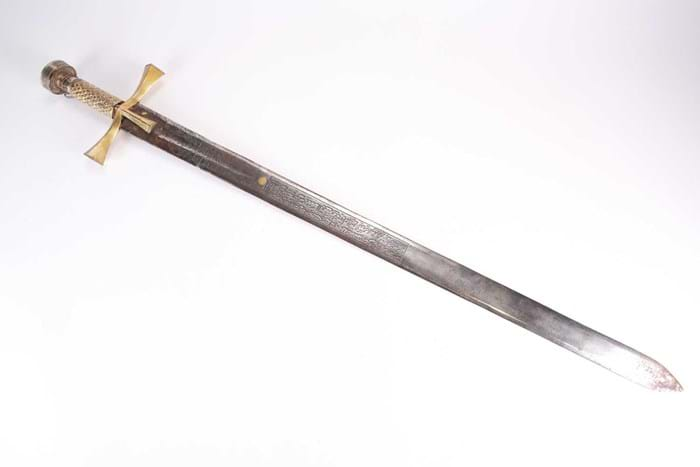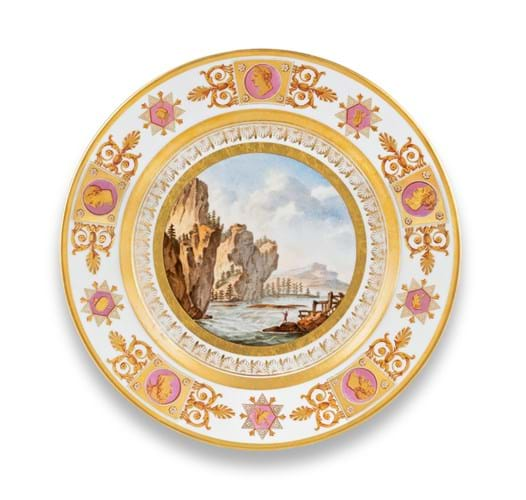1. Japanese netsuke – €30,000
The sale of fine netsuke and sagemono held by Galerie Zacke in Vienna on October 29 was topped at €30,000 (£27,300) by this stag antler carving of a bakemono octopus (takohachi), above.
It is signed Masatoshi for the great 20th century Tokyo carver Nakamura Tokisada (1915-2001).
A memorable carving dated April 1974 and pictured in The Art of Netsuke Carving by Masatoshi as told to Raymond Bushell (1992), it assumes the form of an eight-armed devilfish wearing a headband and a short coat. The forked tongue he holds in one of its three-clawed hands is a symbol for double-dealing.
The price, well above the €2500-5000 estimate, is indicative of a rising interest in stag antler carvings (they carry none of the difficulties of elephant or marine ivory) and of the work of the best 20th century carvers.
It was formerly in the collection of Californian Richard Silverman (1932-2019), owner of one of the largest private collections of netsuke outside of Japan.
Silverman, later a consultant for Christie's, Sotheby's, and Bonhams, lived in Tokyo between 1964 and 1979 and had began to collect netsuke in 1968.
2. Staffordshire red squirrels – £2000
At the Stamford Auction Rooms in Lincolnshire on October 30 this pair of mid-19th century Staffordshire red squirrels sold for a surprise £2000.
As Victorian Staffordshire animals go, squirrels are among the rarest. The subject was a relatively common one in 18th century porcelain and pottery (Meissen, Derby and Ralph Wood all made memorable models) but relatively few mid to late 19th models appear to have been made.
There are several different recorded designs with this one, standing 9in (22cm) high and modelled eating nuts in a bocage, among the best.
Of course all Staffordshire squirrels are reds: it was the only squirrel Europeans knew prior to the accidental introduction of the grey 1876.
3. Sudanese sword – £8200
Estimated at £200-300, this kaskara (a type of traditional sword) sold for £8200 at Dawsons in Maidenhead on October 28.
It follows a Sudanese sword type popular into the 19th century but the use of silver-gilt to the pommel and pinecone grip and gold inlay to panels of Arabic script, and a tugra (seal or mongramme), were not translated. Similar weapons were commissioned by Sudanese sultans for presentation purposes.
A kaskara of this type dated 1302AH (corresponding to 1884) with a presentationn inscription ‘from Sultan Ali Dinar to his son Mazmal' was sold by Bonhams in 2016 for £3000. Ali Dinar ibn Zakariya (1856-1916) was the last Sultan of the Kayra dynasty in Darfur, overthrown by the British in 1916.
4. Sèvres service with Napoleon link – £22,000
The Bonhams sale titled Napoleon Bonaparte: The British Sale on October 27 included several pieces of Sèvres from important imperial services. This dessert plate decorated with a river landscape titled Vue de val Travers dans le Comté de Neuchâtel is from the service with 'Vues de Suisse' given by Napoleon to his stepson, Eugène de Beauharnais, Viceroy to Italy c.1811.
Estimated at £0000-0000, it sold at £22,000.
The service contained 72 plates and is of particular technical interest due to the combination of transfer printing and hand-painting in its decoration, a technique not often used in the factory's production.
The particular view on this plate was taken from an engraving after Claude-Louis Châtelet, which was published in the late 18th century plate book Tableaux de la Suisse…
5. Wild West broadside from c.1853 – £6500
Joaquin Murrieta Carrillo (1829-1853), also known as 'The Bandit' or 'Robin Hood of the West', was notorious during the California Gold Rush.
An outlaw whose tale of heartbreak and revenge became the stuff of folklore, his death was so disputed, the California Rangers decided to preserve his remains in alcohol in order to tour the county with proof of his demise.
As this broadside from c.1853 suggests, the head of Joaquin along with the hand of his most famous associate Manuel 'Three Fingered Jack’ Garcia was put on view on August 12 at the Stockton House.
A much copied poster (it was reprinted in the 1930s) this seemingly original survivor in browned and chipped condition, sailed past estimate of £200-300 to bring £6500 at Forum Auction in London on October 28.










